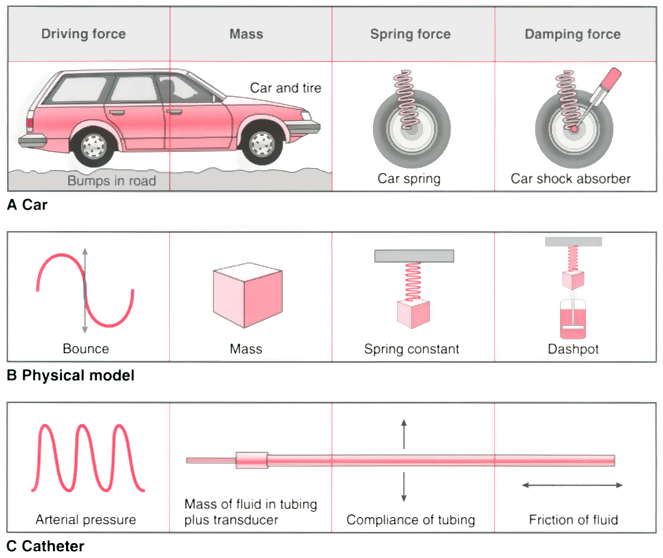 |
 |
Figure 30-13
A to C,
Damping and resonance. Pressure measured in an invasive arterial catheter can actually
overshoot or amplify the real blood pressure. This phenomenon is referred to as
the dynamic frequency response of the fluid-filled arterial line and transducer system.
The phenomenon has a physical model that can generate an equation to predict the
output pressure response, depending on the frequency of the input pressure and several
physical parameters of the system. In the physical model on the right,
driving pressure (arterial blood pressure) acts on a mass (the fluid within the arterial
pressure tubing) by pushing it up and down against a spring, which stores energy
(the compliant pressure tubing), and on a dash pot, which opposes motion in either
direction (the resistance of the fluid as it moves to and fro within the pressure
tubing). Depending on the input frequency, the output may undergo amplification
as it reaches a specific frequency, known as the resonant frequency of the system.
On the left side of the figure is a common phenomenon
noted when a car drives along a bumpy dirt road. In this situation, the driving
force is the bumps in the road, which act on the tire. The car spring is equivalent
to compliance to the pressure tubing, and the shock absorber corresponds to the resistance
of fluid moving back and forth in the arterial line. The mass of the fluid is analogous
to the mass of the front of the car. You may have experienced the phenomenon: when
you reach a certain speed as you are driving along a bumpy road, the front of the
car starts to oscillate with increasing amplitude. If you speed up or slow down,
this phenomenon disappears. The car bounces highest when you have reached the resonant
frequency of this harmonic oscillator. See Appendix
4
for a detailed mathematical description of this process.

 |
